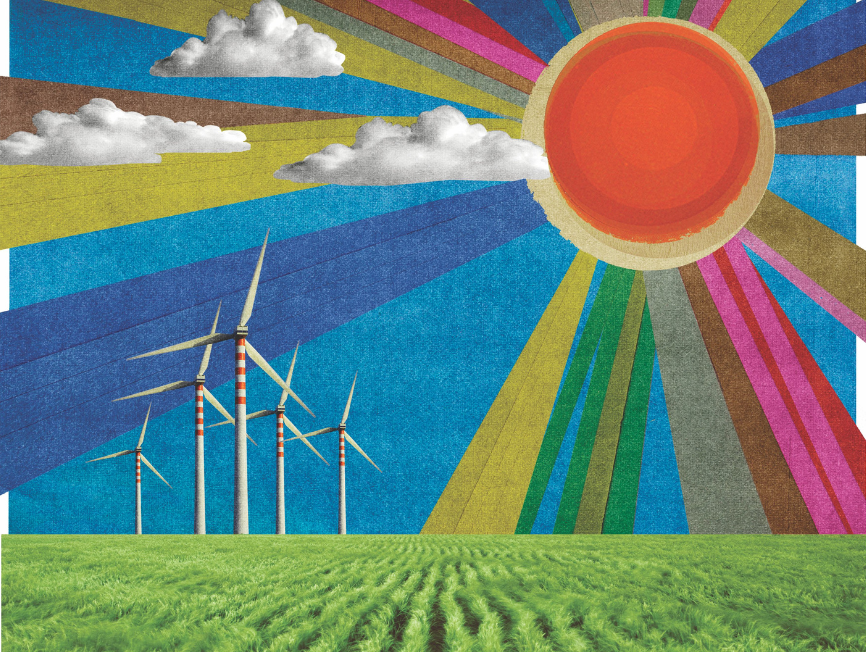This is the toughest job I’ve ever had. The assignment: find reasons to hope that the carbon threat we’ve created on the planet can be turned around. And not just theoretical reasons, but hard numbers to counteract the growing mountain of evidence that we’re on an irrevocable course to global disaster.
Oh, yes. And find this information after the international talks in Durban, South Africa, on the expiring Kyoto Protocol have produced a weak agreement that won’t solve our carbon problem.
So I started looking. I kept remembering the words from the famous 2009 commencement address by environmental writer Paul Hawken: “If you look at the science about what is happening on earth and aren’t pessimistic, you don’t understand the data.”
On the face of it, the data are dreadful. We’ve probably all seen the most important graph. It’s a line in the shape of a hockey stick with its handle rising high, showing how sharply the concentration of carbon dioxide and other greenhouse gases in the atmosphere has risen since we started burning fossil fuels 250 years ago to run our economy.
In fact, just since 1990, the world’s carbon dioxide emissions from burning fossil fuels have risen by 45 percent. That’s significant because it was also 1990 when the world’s developed countries (not including the United States) ratified the Kyoto Protocol, agreeing to reduce their emissions by various percentages by this year. The Canadian government, for example, pledged a six percent reduction. Instead, our emissions have risen 17 percent.
Then there are the graphs showing some of the effects of that higher concentration of carbon in the atmosphere. They include average air temperature near the planet’s surface, ocean temperature, ocean acidification — all rising. Or the ones that show the loss of sea ice and the disappearance of coral reefs — all climbing. Species on the brink of extinction? High, and rising sharply for birds, mammals, amphibians, reptiles, sharks and many other fish. At the same time, the voracious human population has surpassed seven billion and continues to soar. Almost every single indicator of the planet’s health is going in the wrong direction.
And then there’s the distressingly inflamed rhetoric about climate change. In the United States, which is in the throes of finding a Republican candidate to run against President Barack Obama in next November’s election, climate has become an unmentionable on Capitol Hill. Obama himself, who promised to tackle the challenge of rising carbon dioxide emissions, has done little. The Republicans who are vying for his job spent the fall declaring that the whole issue of human-caused global warming is a “hoax” and a “scam.”
Here in Canada, we’ve just withdrawn from a legally binding commitment to reduce emissions. But before we withdrew, we weren’t doing much to reduce them anyway.
At the same time, the consequences of too much carbon dioxide in the atmosphere are leaping from the scientific graphs into our own back- yards. Gardeners across North America are noticing that plants bloom earlier. Birders are finding species further north than ever before. Storms are fiercer. Summers are hotter. Droughts and floods are more intense. The iconic Northwest Passage — once frozen year-round — is shaping up to become an international shipping route.
Is all lost? Are there points of light in all this darkness?
First, the much-disparaged Kyoto Protocol. You’d never know it from the spin, but, actually, it worked.
While it’s true that the world’s carbon dioxide emissions rose dramatically from 1990 levels, most of the world’s nations were not bound by the protocol. When you look only at those countries bound by targets and average things out, emissions fell by far more than the signatories promised, even as their populations grew.
By the end of 2009 (according to numbers the countries themselves submitted to the United Nations Framework Convention on Climate Change, which administers the protocol), emissions from the developed world dropped 11.5 percent, a figure that includes the United States, which didn’t ratify the protocol. A separate study conducted by the European Union’s Institute for Environment and Sustainability projects that emissions will have dropped 16 percent by the end of this year.
Particular heroes, according to the UN numbers, are Britain, Germany, France, Monaco and the Scandinavian countries. Their economies grew even as their emissions dropped by double digits. Germany, for example, Europe’s industrial engine, managed to cut emissions by 26.3 percent from 1990 levels by 2009. So much for the argument that slashing carbon hurts the economy.
There are other bright spots. The United States didn’t do well on cutting emissions as a whole, but it made strides in cutting emissions per capita even though it has no national plan to do that. In the 20 years since 1990, emissions for every American dropped 14 percent. In Canada, by contrast, emissions per person dropped just two percent over the same period.
There are lots of reasons for the declines among industrialized nations. One is that when the world’s economy hit a wall in late 2008, people began using less fuel and spouting fewer emissions. But the lower numbers have persisted since the economy revved up again in 2009. The overall drops are also the result of a raft of government policies — mainly European — that pushed green technologies, fostered renewable energy and encouraged people to use less power.
Speaking of renewable energy, by 2010, it had grown to make up more than eight percent of the world’s total energy supply. Traditional fossil fuels are down to 86 percent, the lowest in decades. And when it comes to producing electricity, the portion derived from renewables is predicted to jump to as much as 45 percent by 2035, according to a recent edition of the World Energy Outlook, the global energy bible.
The world’s solar energy capacity has grown by a hefty 40 percent a year on average over the past decade. In 2010 alone, solar energy jumped by 71 percent, mainly in Europe. In that one year, Europe’s solar power nearly doubled.
Wind power capacity grew by leaps and bounds, too, up 22.5 percent in 2010 alone. That represents investments worth US$65 billion. Intriguingly, most of that investment happened in the developing world, a market that has struggled to take part in more expensive renew- able technology and has been helped by international financing.
In the past few years, the financial world also woke up to the fact that carbon matters, even if some of North
America’s politicians didn’t wake up too. For the first time in history, climate change is firmly on the boardroom table. I think this is one of the most significant advances, because in our society, money talks. Financial regulators all over the world are forcing businesses to think about their car- bon use, figure out how much carbon they consume and put a value on it.
Not only that, but many securities regulators are also forcing businesses to tell investors about any significant risks they face as the climate changes. It’s no longer a question of a chief executive hiding his or her head in the sand or spouting climate denials to the press. If the evidence points to an investor risk from the altering climate, then the company has a legal obligation to know about it and to inform the people who are putting money into the business. If they fail to do so, it’s a serious infraction of securities rules, and company executives could face sanctions or even jail time.
Not only that, but many institutional investors — the ones who manage pension funds and other massive pools of money — now require information about how companies are dealing with the high-carbon world, and they’re making investment decisions based on this information, or the lack of it. This means they could well divest billions of dollars from companies who don’t have a plan to deal with carbon or who refuse to discuss it.
The Carbon Disclosure Project, representing more than 500 institutional investors that control US$71 trillion in assets, demands information on carbon from the planet’s biggest companies. When the project began in 2003, 235 companies supplied information. Now, more than 3,000 companies from every major economy in the world have complied.
At the same time, thousands of teenagers involved in the group iMatter have sued the United States and several state governments for failing to curb carbon dioxide concentrations. The lawsuit is a tactic developed by James Hansen, one of the world’s leading climate scientists and an adviser to iMatter, who says he despairs that feuding American politicians will ever agree to cut emissions. Instead, he argues, the courts must force their hand by ruling on whether the government is breaking the law and endangering citizens by failing to curb carbon dioxide emissions.
This may be the ultimate game changer. The United States is the heart of the carbon problem. Not only is it the second-biggest national emitter every year, but it’s also the historical heavyweight when it comes to emissions. According to Hansen’s calculations, published in his book Storms of My Grandchildren, the United States is responsible for 27.2 percent of the cumulative fossil fuel emissions from 1751 to 2008. The next nearest is China, with 9.1 percent.
China may be a bright spot, too, although we rarely hear mention of the green advances the world’s most populous country is making. Although China overtook the United States as the largest national emitter a few years ago (mainly because it’s producing goods for the rest of the world), its yearly emissions per person are still low: 6.8 tonnes in 2010 compared to the United States’ 16.9. Xie Zhenhua, the minister in charge of China’s climate policy, recently pledged that his country’s per capita emissions would never reach those of the United States because that would be a “disaster for the world.”
One sign that it means business: in 2010, China doubled its wind and solar power capacity for the sixth year in a row. Unlike the United States and Canada, China also has legally binding national targets for reducing the amount of fossil fuel energy used for every unit of economic growth.
Finally there is the groundswell of global action from citizens, communities and municipal leaders. The Occupy movement, which began on Wall Street in New York last fall and has spread around the world, named climate change as a central concern.
And the muscular C40, made up of 40 of the big- gest cities in the world, including New York, London, Tokyo, Jakarta and Toronto, has become a leading force in reducing emissions. The mayors of these cities are bypassing international diplomatic gridlock and simply reducing the emissions they control. Which is a lot. About 70 percent of global carbon dioxide emissions are produced in cities. In June, the World Bank signed a groundbreaking agreement to provide technical assistance and money for C40 projects to accomplish emissions cuts.
Is it enough? Well, no one is saying that the glass is half full. But never, in all of world history, has there been so much impetus from the people, the financial world and even politicians to turn us back from the brink. Today, when you change to a low-energy light bulb, or ride your bike instead of taking the car, or turn down your thermostat, or eat organic, or take part in a protest or write a letter to a politician, you’re part of something far, far bigger.
To my mind, that matters. It means every action we take, every iota of pressure we exert, builds on itself. It means you can keep on hoping and taking action and not consider yourself irrational.
***
This story first appeared in The United Church Observer’s January 2012 issue with the title “A Planet’s Progress.”















